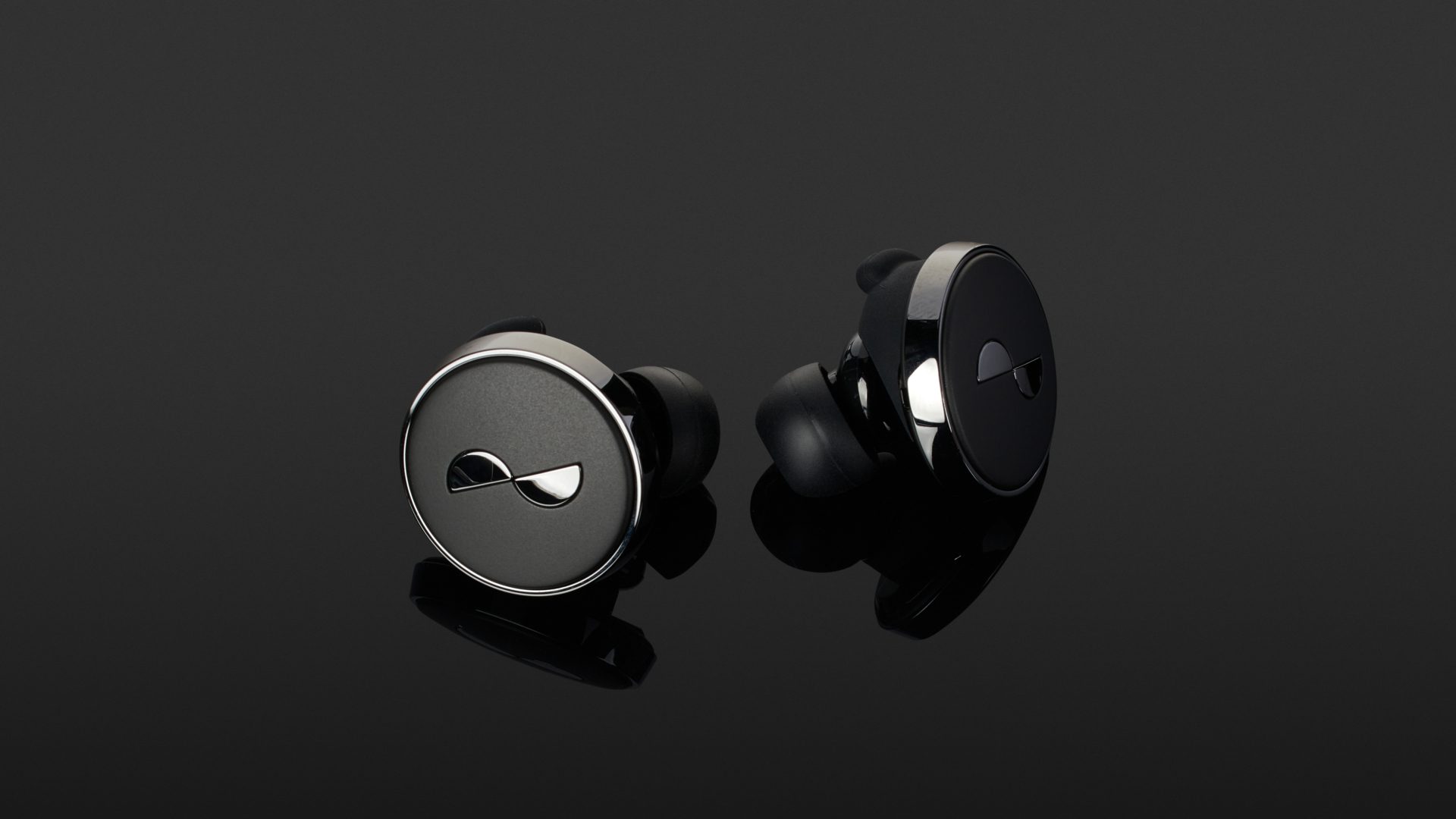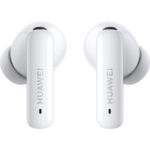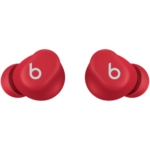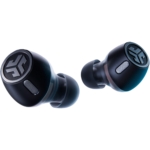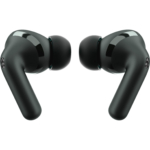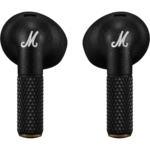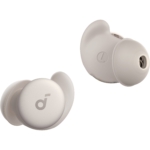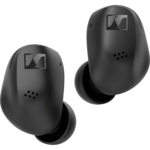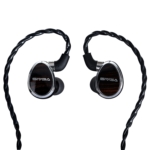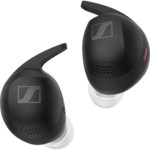Technically, Nura operates at the cutting edge with the NuraTrue Pro. In addition to offering exclusive sound personalisation, the latest Bluetooth standard, aptX Lossless, Dirac Virtuo, adaptive noise cancelling, multipoint functionality and configurable elegant touch control are supported. You can’t ask for much more from true-wireless headphones today because the sound quality was also convincing. As a consequence of these innovations, the Pro version costs significantly more than the standard NuraTrue model but also offers incomparable full features.
In principle, the sound was also convincing in combination with smartphones without the previously hard-to-find Snapdragon 8+ Gen 1 chipset, but even more so with it – so you might be curious about further developments to come from the market. At the same time, you should not overestimate the sound gain for mobile operation. Therefore, the opposite conclusion should be drawn: if you specifically demand high sound quality, you might be better off with a good wired system and, if necessary, a headphone amplifier. For everyone else, the NuraTrue Pro has the best possible mix of sound quality and comfort features currently available. Nevertheless, the manufacturer could still sharpen up in the area of noise cancelling. If you want to treat yourself to very advanced True-Wireless headphones and are prepared to put almost 360 euros on the table, then you should definitely try out the NuraTrue Pro.
- convincing sound quality
- unique hearing personalisation
- aptX Lossless
- Dirac Virtuo
- good and flexible touch control
- improved battery performance
- improved voice quality
- improved noise cancelling
- ANC rather discreet
- significantly higher price than NuraTrue
The Nura NuraTrue Pro comes with impressive functionality. In addition to the Australian manufacturer’s unique hearing personalisation, these true-wireless headphones are the first device ever to offer lossless sound data transmission via Bluetooth and thus finally want to catch up with the wired competition. The result is a TWS headphone in the upper price range that meet almost every requirement.
Nura is undoubtedly one of the technical innovators in the field of headphones. In this case, they have devised a unique customisation to suit the user’s hearing, and this is used for all their models. This includes their new model, the true-wireless NuraTrue Pro, which are the first headphones ever to feature aptX Lossless and enable lossless sound transmission via Bluetooth with CD resolution.
After the original over-ear model Nuraphone, the neckband model NuraLoop, the TWS debut NuraTrue and the affordable NuraBuds, the Melbourne-based manufacturer has once again expanded the “True Wireless” range and brought it up to the latest technical standard, which includes adaptive noise-cancelling, Bluetooth 5.3 and seamless multipoint operation. As in the past, this project was launched via Kickstarter.
On first impression, they demonstrated the manufacturer’s typically impressive design. The charging case is made of robust, matt plastic. Inside, the ergonomically shaped in-ears with their strikingly large “plates” on the outside are reminiscent of the standard model that is still available, but they are made of higher-quality materials and have ceramic appliqués, so they look better. However, it is sometimes a bit fiddly to remove the earpieces from the case.
NuraTrue Pro and NuraTrue in comparison
The main selling point of the Pro version is the aptX Lossless Audio codec or aptX Adaptive variant, which can be used instead of aptX, AAC and SBC, but these codecs are still available as fallback modes. Spatial Audio, a switchable sound enhancement from the Swedish manufacturer Dirac, is also available. Other special features include adaptive noise cancelling with wind suppression and overload protection.
For improved call quality during telephone conversations, there are now four instead of two microphones per side, one of which is a bone conductor. For voice transmission, the manufacturer uses a built-in Qualcomm Snapdragon chip with background noise suppression.
The NuraTrue Pro continues to support wireless charging and scores points with an increased battery capacity of up to eight hours or 32 hours with the charging case. In addition, the QuickCharge charging time has been reduced to one hour and five minutes (for one hour of playtime).
The NuraTrue Pro codecs: aptX Lossless, aptX Adaptive
A first for the headphone sector is the audio codec aptX Lossless. For the first time, this makes it possible to transmit audio signals in uncompressed form over a Bluetooth wireless link and so do justice to the relevant offers from streaming service providers such as Tidal or Apple.
In principle, Bluetooth 5 has long offered the required range for this, but in practice, it limits the data transfer to about 1.2 Mb/s. However, this is not sufficient for a stereophonic signal with CD resolution (16-bit, 44.1 kHz) with linear transmission (1,410 kb/s). Nevertheless, aptX Lossless gets there by compressing the data, but unlike other codecs, it does so losslessly with a bit-accurate restoration of the original. Manufacturer Qualcomm thus surpasses the previous flagship codec LDAC and at the same time remains backwards compatible with aptX Adaptive/Classic (up to 24 bit/96 kHz at 880 kp/s). Apple mobile devices, which continue to rely on the AAC codec, continue to be a separate case, as their transfer rate is a maximum of 256 kb/s.
The prerequisite for Lossless operation is the availability of corresponding chipsets in the transmitter (Snapdragon 8+ Gen 1) and headphones (QCC5171 / S5). Nura currently recommends the Asus smartphone models ROG Phone 6 and the device we used for our test, the Zenfone 9 (see Qualcomm’s website for more info).
In practice, this is still unnecessarily confusing for the user: for example, Nura told us that aptX Lossless is a subordinate function of aptX Adaptive. This information makes it easier to understand that the Zenfone 9 identifies aptX Adaptive as an audio codec. For clarity, the Nura app should display the corresponding resolution (aptX Adaptive (HQ) 44.1khz), but it did not do so with the current firmware (400178) at least for me.
Sound enhancement thanks to Dirac Virtuo
A sound enhancement algorithm can be switched on with the Spatial Audio function. Technically, this involves processing both the left and right stereo channels on each side of the headphones to simulate a studio environment with monitors, using crosstalk and supplementary time corrections, among other things, which should ultimately result in a more realistic spatiality (details in the white paper at www.dirac.com). The sound reproduction should not only approximate a normal loudspeaker but also lead to a result that more closely corresponds to the studio situation with which the sound material was evaluated. This means it uses additional computing power, so it no longer fully enables the above-mentioned lossless transmission but cuts it down to about 80 per cent.
An observation on lossless operation: A technical step towards lossless sound transmission via Bluetooth is overdue but is somehow also a bit of a tragedy. We are actually celebrating the possibility of sound transmission in CD resolution – a standard that goes back to 1979! In addition, lossless transmission is only guaranteed with a stable wireless link, i.e. at close range and without Dirac sound enhancement. The fact that true hi-res formats such as 24-bit/192 kHz or DSD are now more than twenty years old is apparently not all that important in the world of wireless headphones.
The NuraTrue Pro in practice
The functionality offered is completely impressive. But first, you have to get used to twisting the in-ear headphones into your ear. These lightweight earphones (8.6 grams each) then fit comfortably and securely in my ear for a long time, even if they were not particularly tight. I would not describe this IPX4-certified model as sports headphones, but they were perfectly suitable for mobile use. The ergonomic design and seven fitting pieces made of silicone and memory foam ensured an optimal fit.
Pairing was carried out easily, was very fast, and with a stable wireless link that extends over several rooms, was also successful when further connections were made.
The controls also earn top marks: There are four touch options per side, which can be freely configured via the app. Thus, the transport functions, level control, switching between noise cancelling and transparency functions, handling of calls and summoning the voice assistant can be set up as required. Even better: The functions are triggered accurately, and operating errors were rare compared to the competition. Key feedback for multiple clicks in the form of an ascending tone sequence is a practical feature. Multilingual voice prompts are also provided. Multipoint connections are announced and allow the practical use of multiple transmitters. In addition, there is an automatic pause function that can be configured as required.
Of course, a single earpiece can be used on its own. The device we tested was exemplary in its dynamic performance, and in practice, it was easy to switch between one and both earpieces.
The well-designed app for iOS and Android is somewhat slow to open because a secure connection to the server must be established. This gives you exclusive access to your private listening profile, which requires a one-time registration with age information. However, you can, of course, also work offline to use noise cancelling and the function control.
Creating the essential sound personalisation via the app is easy and also controls the degree of sealing in the ear. This is the only way that the measurement can be carried out as desired and, as a result, the required sound improvement be achieved.
The cochlea of your inner ear is stimulated with test tones. Highly sensitive microphones subsequently register so-called otoacoustic emissions, which themselves generate vibrations in response to the incoming sound. Instead of a subjective hearing test, Nura objectively measures and evaluates the user’s hearing ability – something no competitor offers. The result is a personalised sound curve which is stored in the device that processes the sound material. The bass content of the playback is determined by an immersive slider. In addition, a five-band EQ with frequencies at 200, 1,000, 3,000, 5,000 and 10,000 Hz can be used to fine-tune the sound (±6 dB in small steps), but unfortunately, there are no storage locations.
The speech quality during telephone calls was astonishingly good, and this means that the NuraTrue Pro are certainly to be recommended for frequent callers and for use in working life. Disturbing background noise and low frequencies were suppressed, as was the wind. In addition, an extended frequency range was used for transmission (Qualcomm aptX Voice, 32 kHz), and this enables a more natural voice transmission.
Finally, I would describe the battery life of the NuraTrue Pro as entirely practical. Even on longer trips, the test device did not run down.
How good is the NuraTrue Pro’s noise cancelling (ANC)?
The NuraTrue Pro’s noise cancelling adapts to the environment as an adaptive system. It performed well in everyday use but was not adjustable and not especially intensive. Thus, the level of ambient noise was reduced, and an extended quiet zone was created, but this was rather subtle compared to some competitors. Low-frequency noises like a passing bus and a rattling keyboard were still audible at times. These headphones also share a degree of sensitivity to wind with other noise-cancelling systems, despite a dedicated protective circuit.
The circuit is permanently active as long as you do not switch to transparency mode, something that can be done quickly and conveniently. The circuit can only be completely deactivated in the default settings. Real comparisons are hardly possible as the level drops and the sound quality decreases with deactivation. Listening pleasure is, therefore, only possible when ANC is switched on. In short: The NuraTrue Pro’s noise cancelling definitely represents added value for mobile use, but it is not an outstanding argument for purchase on its own.
On the other hand, the transparency function brings a qualitative gain compared to the standard model. The goal of better voice intelligibility is certainly achieved, even if the sound loses some of its naturalness. In the future, I could imagine configurability becoming available in the app. After all, the transparency function can only be switched and not temporarily activated.
The NuraTrue Pro’s sound
Owing to the elaborate technology, one should certainly have high expectations of the sound. Personalisation is essential for an adequate listening experience. In fact, in comparison with the neutral position, it is soberingly bland and lifeless. However, according to Nura mastermind Luke Campbell, the opposite conclusion that good sound begins with a high-quality passive basic structure does not apply in this case: the otoacoustic measurement process requires the highest possible passive attenuation. Only when this measurement is done correctly do the filters for the custom-made, dynamic 10mm drivers and the rest of the hardware take effect as desired. The drivers themselves are custom-made, double-vented drivers in three layers of titanium, which must have a wide frequency spectrum and the lowest possible distortion for the measurement process.
The sound is basically comparable to the NuraTrue, but comes out ahead in the details, especially when using the aptX adaptive codec with high data transmission. I would describe the general tuning as balanced with a focus on a punchy sound reproduction that reveals itself even at low levels. These are headphones that can provide a lot of listening pleasure for mobile use. With a switchable high-gain mode and a tuned volume limiter, the NuraTrue Pro should also meet increased level requirements.
For our test, we were able to use an Asus Zenfone 9 as well as an iPhone 8 with AAC codec, which is currently the normal standard in terms of lower-quality codecs.
The fact that the NuraTrue Pro does not necessarily strive for the highest neutrality is already apparent from the subjective setting of the immersion parameter. The bass capacities were considerable, so I mostly placed the control at -1; I even lowered the bass a little. If you want a more voluminous sound experience, you can adjust it. Personally, I no longer consider values outside the central trio of -1, 0, and +1 to be a gain.
The general bass reproduction was powerful and warm. Contours were clearly reproduced, and tonality was still well discernible. Pressure was abundant, for example, on Donalds Fagen’s classic “Morph the Cat”. Real low bass was also no problem for the unit we tested – the really low registers were reproduced cleanly and not overemphasised.
In the midrange, the NuraTrue Pro reliably brought out the timbre of voices and acoustic instruments and did not get out of step even with complex mixes such as the middle section in Toris Amos’ “Star Whisperer”. The intimacy of close-ups was also well transmitted so that the necessary emotionality was conveyed. At the same time, distorted guitars and other aggressive sounds were conveyed with complete satisfaction.
In the higher frequencies, the NuraTrue Pro delivered an open sound image. However, as expected, the airiness and detail resolution of expensive wired designs were missing. Harshness did not come to the fore as long as the mix did not provide it. In this respect, these headphones were rather uncritical, as the treble range receded slightly behind the bass range, which was why I resorted to the aforementioned discreet lowering in Immersion mode.
Nevertheless, tracks like Yello’s “Arthur Spark” delivered plenty of subtleties and a really nicely animated stereo panorama. Such exuberant electronic mixes were a joy to immerse myself in. Compared to the wide panorama, the spatial depth was less pronounced, reverberant spaces could still be understood well, and this also applied to the general dynamics.
Sound check for the NuraTrue Pro codecs
The NuraTrue Pro’s fluid multipoint support allows codec comparisons to be made. So I pitted the Zenfone 9 with aptX Lossless and aptX Adaptive with Spatial Audio function against Apple’s AAC codec. Indeed, the quality of the reproduction was slightly different and demonstrated a little more “depth”, detail resolution and dynamics with an Asus smartphone. On the whole, the sound reproduction shifts forward a little.
In Lossless mode, for example, the space surrounding Holly Cole’s voice and the dynamically played double bass in “I Can See Clearly Now” became more audible. This gave the recording an increased three-dimensionality, where the sound elements became more individually tangible. Closeness, space, contour and dynamics were more “colourful” and precise in their reproduction compared to AAC. The sound enhancement with Dirac Virtuo was subtle but actually delivered increased spaciousness of the individual sound sources and the overall reproduction. It also shifted the sound slightly outside your head. In practice, I found that I left this function switched on.
The bottom line was that the differences were rather subtle and, in my opinion, hardly relevant to everyday mobile listening. However, the situation was different in quiet listening environments, where one could focus more on sound reproduction and definitely perceive the added value of the optimised wireless link. This is where the NuraTrue Pro really competes with wired models. In the end, I would describe the performance as impressive, but I would not classify the NuraTrue Pro beyond its price range. So, in terms of sound, the device we tested was not really competition for wired systems such as the Sennheiser IE 600.
In principle, the personalised measurement of your own ear was certainly an ingenious idea. But you will also pay a price for the integrated measurement technology and electronic equalisation. In addition, the system disregards the brain’s ability to compensate and be retrained.
Technical specifications
- Ear couplingIn-ear
- Typeclosed
- Transducer principledynamic
- Frequency response (headphones)20 - 40.000 Hz
- Weight without cable8,6 g each, case 51,2 g
What's in the box
- 4x pairs silicone ear tips (XS, S, M, L)
- 1x pair foam ear tips
- 2x pairs silicone secure-fit wings (optional)
Special features
- BT codecs: SBC, AAC, aptX Classic, aptX Adaptive, aptX Lossless
- BT version: 5.3












